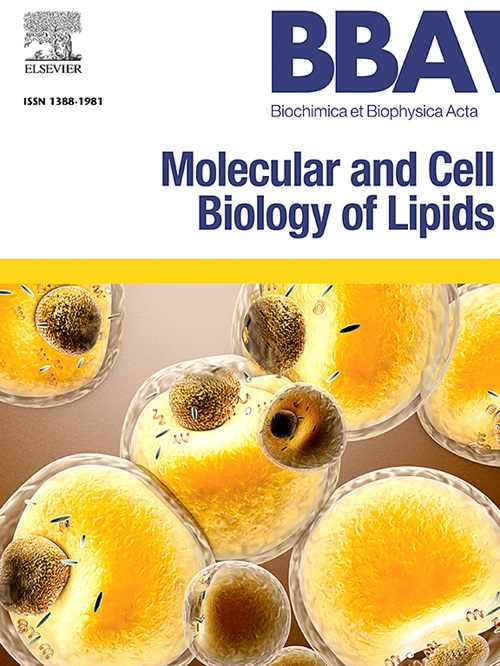How the liver transcriptome and lipid composition influence the progression of nonalcoholic fatty liver disease to hepatocellular carcinoma in a murine model
IF 3.9
2区 生物学
Q2 BIOCHEMISTRY & MOLECULAR BIOLOGY
Biochimica et biophysica acta. Molecular and cell biology of lipids
Pub Date : 2024-11-05
DOI:10.1016/j.bbalip.2024.159574
引用次数: 0
Abstract
The incidence of nonalcoholic fatty liver disease (NAFLD) has been steadily increasing in Western society in recent years and has been recognized as a risk factor for the development of hepatocellular carcinoma (HCC). However, the molecular mechanisms underlying the progression from NAFLD to HCC are still unclear, despite the use of suitable mouse models. To identify the transcriptional and lipid profiles of livers from mice with NAFLD-HCC, we induced both NAFLD and NAFLD-HCC pathologies in C57BL/6J mice and performed RNA-sequencing (RNA-seq) and targeted lipidomic analysis. Our RNA-seq analysis revealed that the transcriptional signature of NAFLD in mice is characterized by changes in inflammatory response and fatty acid metabolism. Moreover, the signature of NAFLD-HCC is characterized by processes typically observed in cancer, such as epithelial to mesenchymal transition, angiogenesis and inflammatory responses. Furthermore, we found that the diet used in this study inhibited cholesterol synthesis in both models. The analysis of lipid composition also showed a significant impact of the provided diet. Therefore, our study supports the idea that a Western diet (WD) affects metabolic processes and hepatic lipid composition. Additionally, the combination of a WD with the administration of a carcinogen drives the progression from NAFLD to HCC.
在小鼠模型中,肝脏转录组和脂质组成如何影响非酒精性脂肪肝向肝细胞癌的进展。
近年来,非酒精性脂肪肝(NAFLD)的发病率在西方社会稳步上升,并被认为是肝细胞癌(HCC)发病的一个危险因素。然而,尽管使用了合适的小鼠模型,但从非酒精性脂肪肝发展为 HCC 的分子机制仍不清楚。为了确定非酒精性脂肪肝-HCC小鼠肝脏的转录和脂质特征,我们诱导C57BL/6J小鼠发生非酒精性脂肪肝和非酒精性脂肪肝-HCC病变,并进行了RNA序列(RNA-seq)和靶向脂质体分析。我们的RNA-seq分析表明,小鼠非酒精性脂肪肝的转录特征表现为炎症反应和脂肪酸代谢的变化。此外,NAFLD-HCC 的特征还包括在癌症中观察到的典型过程,如上皮细胞向间充质转化、血管生成和炎症反应。此外,我们还发现本研究中使用的饮食抑制了两种模型中胆固醇的合成。对脂质组成的分析也表明,所提供的饮食对其有显著影响。因此,我们的研究支持西方饮食(WD)会影响代谢过程和肝脏脂质组成的观点。此外,西式饮食与致癌物质的结合会促使非酒精性脂肪肝向肝癌发展。
本文章由计算机程序翻译,如有差异,请以英文原文为准。
求助全文
约1分钟内获得全文
求助全文
来源期刊
CiteScore
11.00
自引率
2.10%
发文量
109
审稿时长
53 days
期刊介绍:
BBA Molecular and Cell Biology of Lipids publishes papers on original research dealing with novel aspects of molecular genetics related to the lipidome, the biosynthesis of lipids, the role of lipids in cells and whole organisms, the regulation of lipid metabolism and function, and lipidomics in all organisms. Manuscripts should significantly advance the understanding of the molecular mechanisms underlying biological processes in which lipids are involved. Papers detailing novel methodology must report significant biochemical, molecular, or functional insight in the area of lipids.

 求助内容:
求助内容: 应助结果提醒方式:
应助结果提醒方式:


